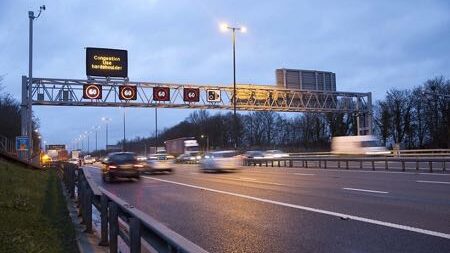Following five months work by the DfT on a smart motorway ‘evidence stock take,’ Transport Secretary Grant Shapps reacted to growing concern about safety on so called “smart” motorways.
A specific 18 point action plan has been published, aimed at improving both safety and public confidence.
So called ‘dynamic hard shoulder’ motorways are to be abolished to end confusion. However the intention seems to be to convert these once part-time hard shoulders to full time live lanes, since amongst various other measures a more rapid rollout of radar based “stopped vehicle detection measures” is proposed, to cover the entire “smart” network inside 3 years.
It’s said this system will typically enable detection of broken down vehicles inside 20 seconds, allowing lane closures far more quickly than at present. The system will be connected to automatically display ‘report of obstruction’ messages on gantry signs, warning drivers a vehicle has stopped ahead – an arrangement currently being trialled on M25 and M3.
Other key actions include spacing of emergency stopping areas no more than a mile apart, and at ¾ mile intervals where possible. Safety improvements in these areas – to be installed by the end of Spring this year – will include bright orange high visibility surfacing, clearer road markings, information on what to do in an emergency, and better, more frequent approach signing – indicating distance to the next stopping point.
Improved technology will also play a part: work with satnav data providers will allow emergency stopping areas to appear on screen when required, while the intention is to make it easier to call for help by working with car makers to improve awareness of the e-Call ‘SOS’ button fitted in newer vehicles.

Work will also focus on making smart motorway schemes generally less confusing – and getting help to broken down vehicles more quickly. This will be led by lowering Traffic Officer attendance times from a current 17 minute average to 10 minutes on smart motorways where spacing between emergency stopping places is over a mile.
The action plan also sets out a government commitment to install ten additional emergency areas on the existing M25 smart motorway, and considering a national programme to provide more stopping places where areas are currently over a mile apart. Highways England will also investigate what more can be done on smart sections of the M6 and M1 – in areas where clusters of incidents have taken place.
More communication with drivers is promised, with updates to the Highway Code, and an additional £5 million committed to targeted national campaigns aimed at further increasing drivers’ awareness and understanding of smart motorways and how to use them confidently. These will launch later in 2020 and include advice on what to do if drivers break down on a smart motorway.
Those determined to use lanes forbidden through red “X” markings will face a crackdown. A change in the law will allow automatic detection of such violations, backed by upgraded camera enforcement, allowing identification of more of the vehicles involved. Transgressors will face a £100 fine and 3 points on their licence, though driver awareness courses may be offered in some cases.
© David Moss
References and more information
The Government news release is here:
https://www.gov.uk/government/news/action-plan-announced-to-boost-smart-motorway-safety
In 2019, the Transport Secretary asked the DfT to carry out an “evidence stocktake” to gather the facts on the safety of smart motorways and make recommendations. A wide range of data has been considered and conclusions drawn. This work is in the Evidence Stocktake Report in Part A of the document, while the Government’s action is in Part B. These documents can be found here:
https://www.gov.uk/government/publications/smart-motorway-evidence-stocktake-and-action-plan
This address links to the download of a 2.49MB, 78 page PDF
A written statement to Parliament about the publishing of the smart motorway evidence and stocktake document, which also summarises the 18 point plan, can be found here:.
https://www.gov.uk/government/speeches/strategic-roads-update-smart-motorways-evidence-stocktake
Dave Moss has a lifetime connection with the world of motoring. His father was a time-served skilled engineer from an age when car repairs really meant repairs: he ran his own garage from the 1930's to the 60's, while Mum was the boss's secretary at a big Austin distributor. Both worked their entire lives in the motor trade, so if motor oil's not in Dave's blood, its surely a very close thing.
Though qualified in Electronics, for Dave it seemed a natural step into restoring a succession of classic cars, culminating in a variety of Minis. Writing and broadcasting about these, and a widening range of motoring matters ancient and modern, gathered pace in the 1970's and has taken over since. Topics nowadays range across the modern motoring mainstream to the offbeat and more arcane aspects of motoring history, and outlets embrace books, websites national and international magazines, newspapers, radio programmes, phone-ins and guest appearances. Spare time: hard graft on the garage floor attending to vehicles old and new. Latest projects: that 1968 Mini Cooper S has finally moved again after 30 years, and when the paint is finished, the 1960 Morris Mini 850 will also soon be ready for the road again...

